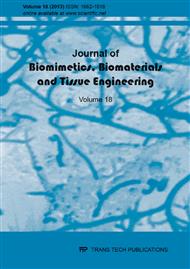[1]
M.P. Ferraz, F.J. Monteiro, C.M. Manue, Hydroxyapatite nanoparticles: A review of preparation methodologies, J. of Appl. Biomater. Biomech. 2 (2004) 74-80.
Google Scholar
[2]
E. Rivera-Munoz, W. Brostow, R. Rodriguez, V.M. Castano, Growth of hydroxyapatite on silica gels in the presence of organic additives: kinetics and mechanism, Mater. Res. Innov. 4 (2001) 222-230.
DOI: 10.1007/s100190000100
Google Scholar
[3]
R.W.N. Nilen, P.W. Richter, The thermal stability of hydroxyapatite in biphasic calcium phosphate ceramic, J. of Mater. Sci.: Mater. Medic. 19(2008)1693-702.
DOI: 10.1007/s10856-007-3252-x
Google Scholar
[4]
A.E. Porter, N. Patel, J.N. Skepper, S.M. Best, W. Bonfield, Comparison of in vivo dissolution processes in hydroxyapatite and silicon-substituted hydroxyapatite bioceramics, Biomater. 24 (2003) 4609–4620.
DOI: 10.1016/s0142-9612(03)00355-7
Google Scholar
[5]
Y. Cai, S. Zhang, X. Zeng, Y. Wang, M. Qian, W. Weng, Improvement of bioactivity with magnesium and fluorine ions incorporated hydroxyapatite coatings via sol–gel deposition on Ti6Al4V alloys, Thin Solid Films. 25915 (2009) 1-5.
DOI: 10.1016/j.tsf.2009.03.071
Google Scholar
[6]
C.V. Ragel, M.Vallet-Regi, L.M. Rodriguez-Lorenzo, Preparation and in vitro bioactivity of hydroxyapatite/solgel glass biphasic material, Biomater. 23 (2002) 1865–1872.
DOI: 10.1016/s0142-9612(01)00313-1
Google Scholar
[7]
N. Pramanik, D. Mishra, I. Banerjee, T.K. Maiti, P. Bhargava, P.Pramanik, Chemical Synthesis, Characterization, and Biocompatibility Study of Hydroxyapatite/Chitosan Phosphate Nanocomposite for Bone, Tissue Engg. Appl. 200 (2009) 1-8.
DOI: 10.1155/2009/512417
Google Scholar
[8]
E.T. Baran, K.Tuzlakoglu, A.J. Salgado, R.L. Reis, Multichannel mould processing of 3D structures from microporous coralline hydroxyapatite granules and chitosan support materials for guided tissue regeneration/ engineering, J. of Mater. Science: Mater. Medici. 15 (2004) 161-165.
DOI: 10.1023/b:jmsm.0000011818.85273.cd
Google Scholar
[9]
N. Eliaz, T.M. Sridhar, U.K. Mudali, B.Raj, Electrochemical and electrophoretic deposition of hydroxyapatite for orthopaedic applications, Surf. Engg. 21 (2005) 1-5.
DOI: 10.1179/174329405x50091
Google Scholar
[10]
G.X. Ni, K.Y. Chiu, W.W. Lu, Y. Wang, Y.G. Zhang, L.B. Hao, Z.Y. Li, W.M. Lam, S.B. Lu, K.D.K. Luk, Strontium-containing hydroxyapatite bioactive bone cement in revision hip arthroplasty, Biomater. 27 (2006) 4348-4355.
DOI: 10.1016/j.biomaterials.2006.03.048
Google Scholar
[11]
L. Medvecky, R. Stulajterova, L. Parilak, J. Trpcevska, J. Durisin, S.M. Barinov, Influence of manganese on stability and particle growth of hydroxyapatite in simulated body fluid, Coll. and Surf. A: Physico chem. Engg. Aspects. 281 (2006) 221–229.
DOI: 10.1016/j.colsurfa.2006.02.042
Google Scholar
[12]
N. Rameshbabu, T.S. Sampath Kumar, T.G. Prabhakar, V.S. Sastry, K.V.G.K. Murty, K.P. Rao, Antibacterial nanosized silver substituted hydroxyapatite: Synthesis and characterization, J. of Biomed. Mater. Res. Part A. 80 (2007) 581–591.
DOI: 10.1002/jbm.a.30958
Google Scholar
[13]
G. Frost, C.W. Asling, M.M. Nelson, Skeletal deformities in manganese-deficient rats, The Anatom. Record. 134 (1959) 37–53.
DOI: 10.1002/ar.1091340105
Google Scholar
[14]
R.M. Leach Jr, A.M. Muenster, Studies on the role of manganese in bone formation: effect upon the mucopolysaccharide content of chick bone, J. of Nutrition. 78 (1962) 51-56.
DOI: 10.1093/jn/78.1.51
Google Scholar
[15]
C.R. Bowen, J.P. Gittings, I.G. Turner, F.Baxter, J.B. Chaudhuri, Dielectric and piezoelectric properties of hydroxyapatite-BaTiO3 composites, Appl. Physics Lett. 89 (2006) 1329061-63.
DOI: 10.1063/1.2355458
Google Scholar
[16]
C.C. Silva, A. Almeid, R.S. De Oliveira, A.G. Pinheiro, J.C. Goes, A.S.B. Sombra, Dielectric permittivity and loss of hydroxyapatite screen-printed thick films, J. of Mater. Sci. 38 (2003) 3713-3720.
Google Scholar
[17]
S. Hontsu, T. Matsumoto, J. Ishii, M. Nakamori, H. Tabata , T. Kawai, Electrical properties of hydroxyapatite thin films grown by pulsed laser deposition, Thin Solid Films. 295 (1997) 214–217.
DOI: 10.1016/s0040-6090(96)09146-8
Google Scholar
[18]
S.L. Shi, W. Pan, R.B. Han, C.L. Wan, Electrical and dielectric behaviours of Ti3SiC2/hydroxyapatite composites, Appl. Physics Lett. 88 (2006) 052903-052903-2
Google Scholar
[19]
P.N. Chavan, M.M. Bahir, R.U. Mene, M.P. Mahabole, R.S. Khairnar, Study of nanobiomaterial hydroxyapatite in simulated body fluid:Formation and growth of apatite, Mater. Sci. and Engg. B. 168 (2009) 224-230.
DOI: 10.1016/j.mseb.2009.11.012
Google Scholar
[20]
M.P. Mahabole, M.M .Bahir, N.V. Kalyankar, R.S. Khairnar,Effect of incubation in simulated body fluid on dielectric and photoluminescence properties of nano-hydroxyapatite ceramic doped with strontium ions, J. of Biomed. Sci.and Engg. 5 (2012) 396-405.
DOI: 10.4236/jbise.2012.57050
Google Scholar
[21]
O.A. Graeve, K. Raghunath, A. Madadi, C.W. Brandon, K.C. Glass, Luminescence variations in hydroxyapatites doped with Eu2+ and Eu3+ ions, Biomater. 31 (2010) 4259-4267.
DOI: 10.1016/j.biomaterials.2010.02.009
Google Scholar
[22]
M. Oht, M. Yasud, Y. Sugiyam, Y. Suzuki, H. Okamur, The Behavior of Rare Earth Ions in Hydroxyapatite, Crystal. ECS Trans. 16 (2009) 141-144.
Google Scholar
[23]
F.A. Muller, L. Muller, C. Zollfrank, P. Greil, Inherent luminescence of annealed biomimetic apatites, Engg. Mater. 311 (2006) 655-658.
DOI: 10.4028/www.scientific.net/kem.309-311.655
Google Scholar
[24]
R.J. Chung, T.S. Chin, H.Y. Cheng, H.W. Wen, M.F. Hsieh, Photo-luminescent hydroxyapatite coating through a bio-mimetic process, Biomol. Engg. 24 (2007) 459-461.
DOI: 10.1016/j.bioeng.2007.07.006
Google Scholar
[25]
T.Ikoma, M. Tagaya, T. Tonegawa, M. Okuda, N. Hanagata, T. Yoshioka, D. Chakarov, B. Kasemo, J. Tanaka, The Surface Property of Hydroxyapatite: Sensing with Quartz Crystal Microbalance, Key Engg. Mater. 396 – 398 (2008) 89-92.
DOI: 10.4028/www.scientific.net/kem.396-398.89
Google Scholar
[26]
A.C. Tas, Synthesis of biomimetic Ca-hydroxyapatite powders at 37°C in synthetic body fluids, Biomater. 21 (2000) 1429-1438.
DOI: 10.1016/s0142-9612(00)00019-3
Google Scholar
[27]
K. Hyun-Min, H. Teruyuki, T. Kokubo, N. Takashi, Process and kinetics of bonelike apatite formation on sintered hydroxyapatite in a simulated body fluid, Biomater. 26 (2005) 4366-4373.
DOI: 10.1016/j.biomaterials.2004.11.022
Google Scholar


